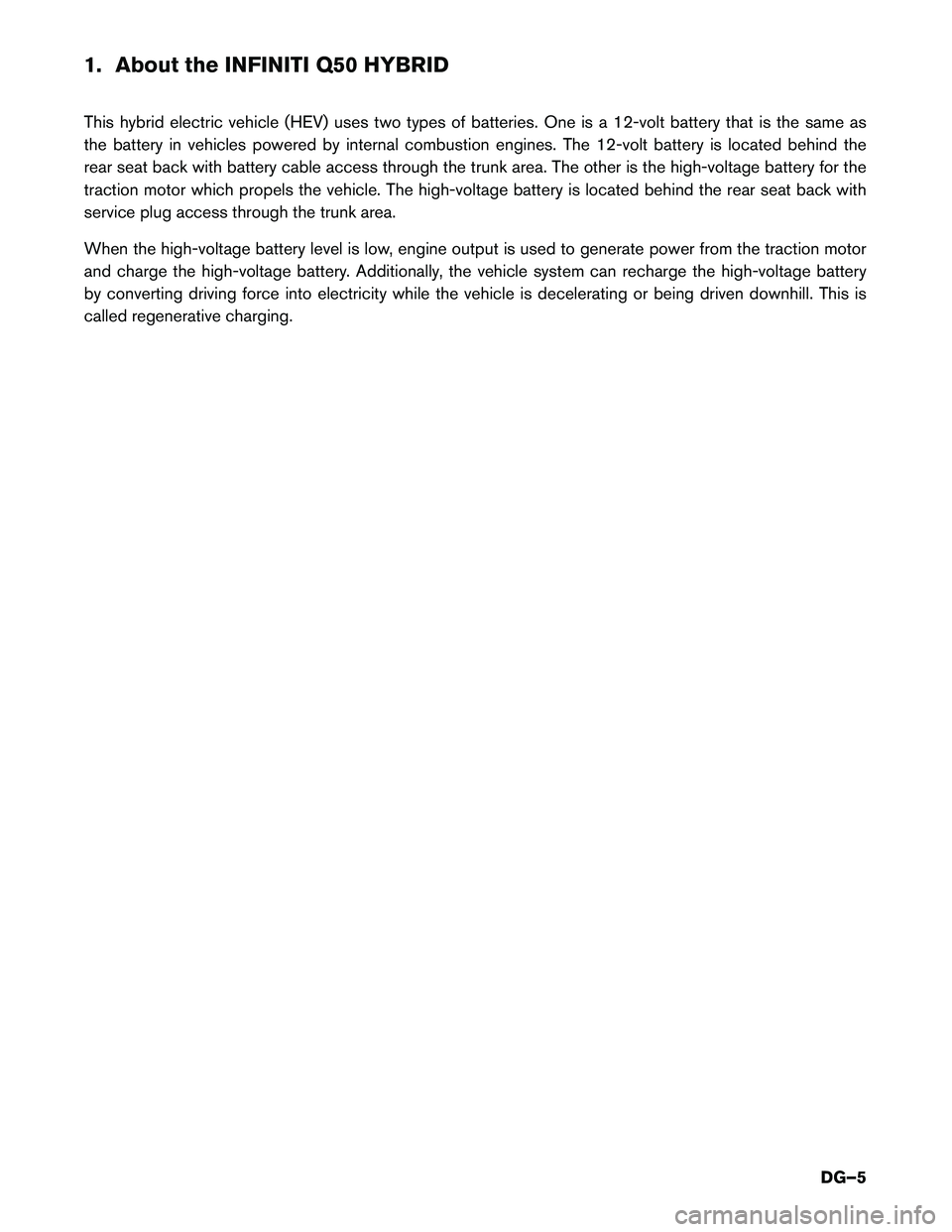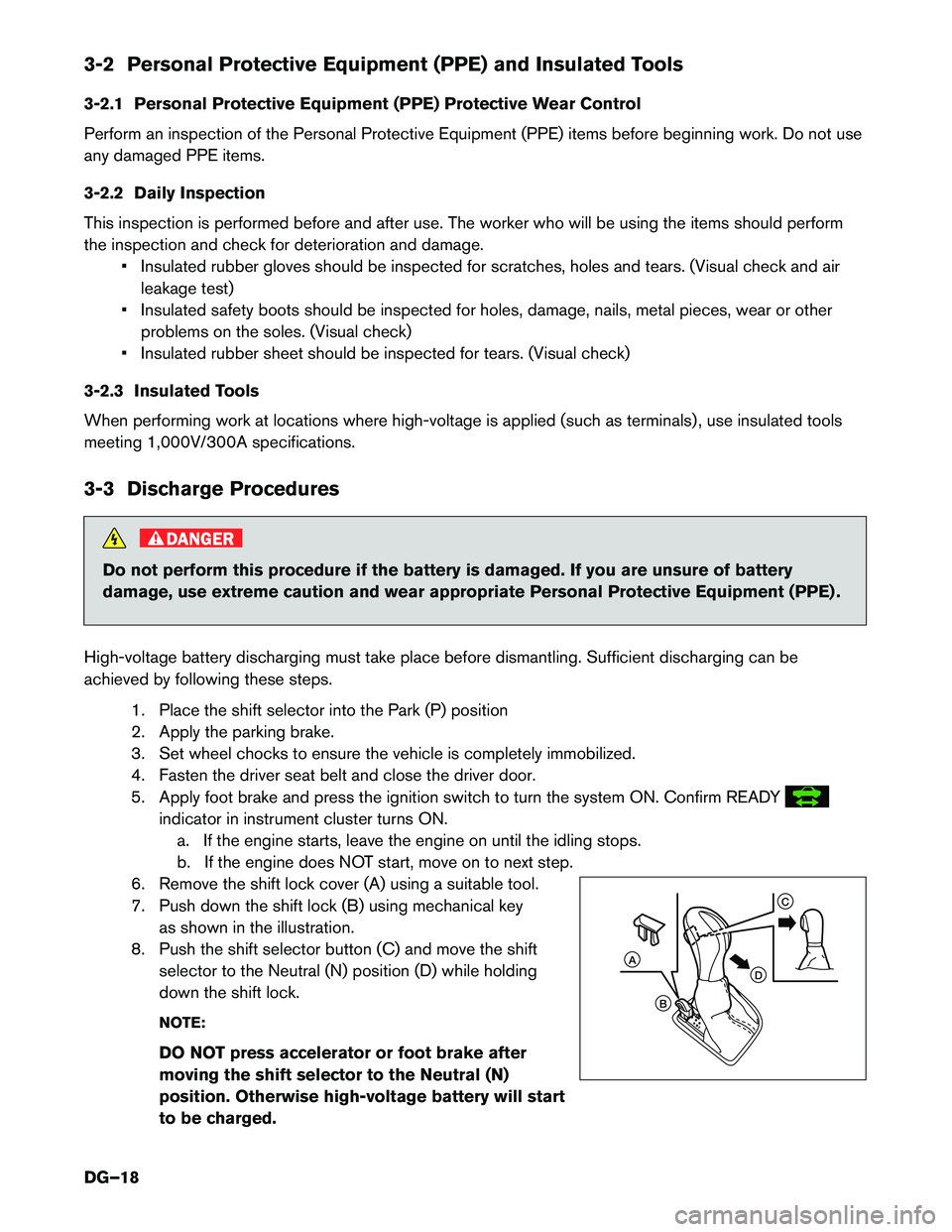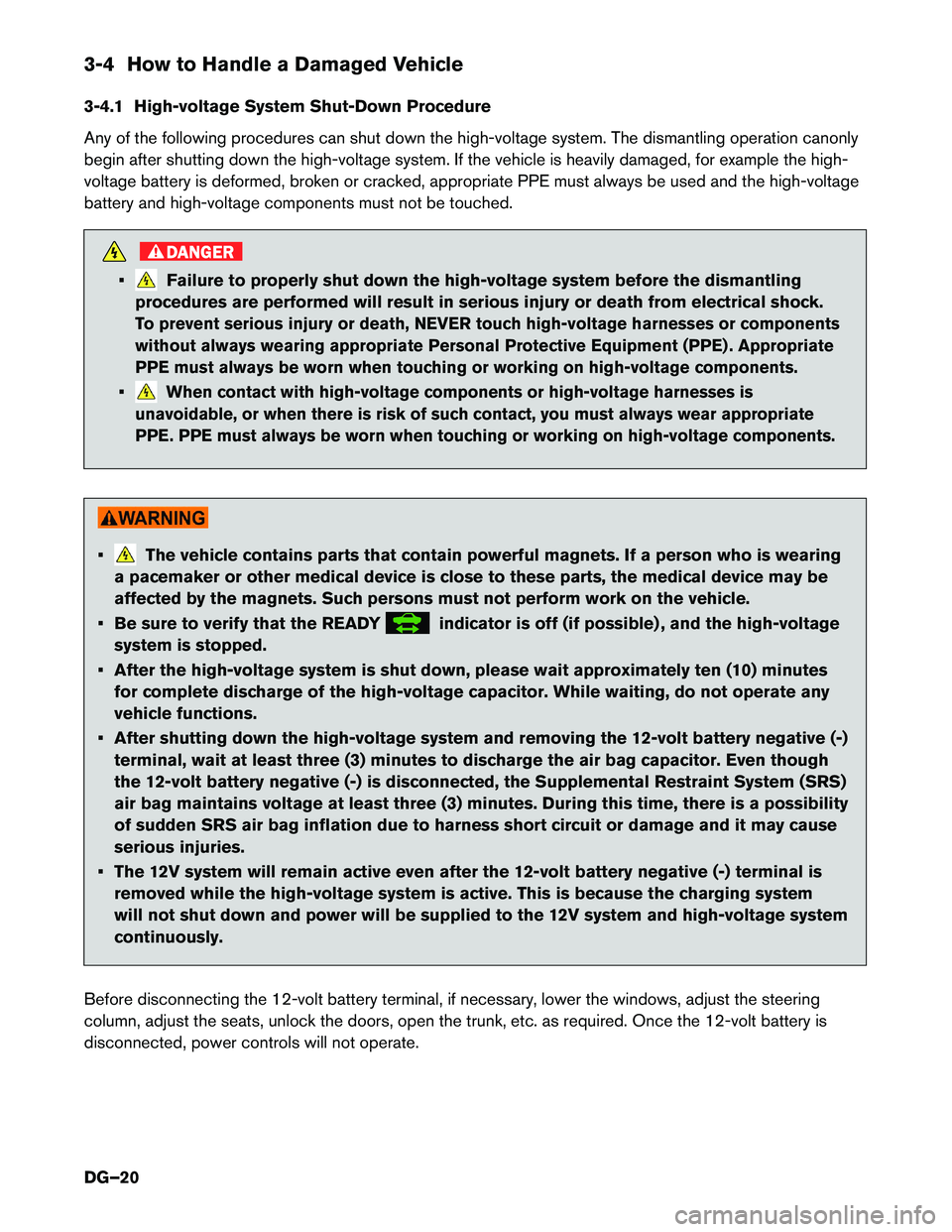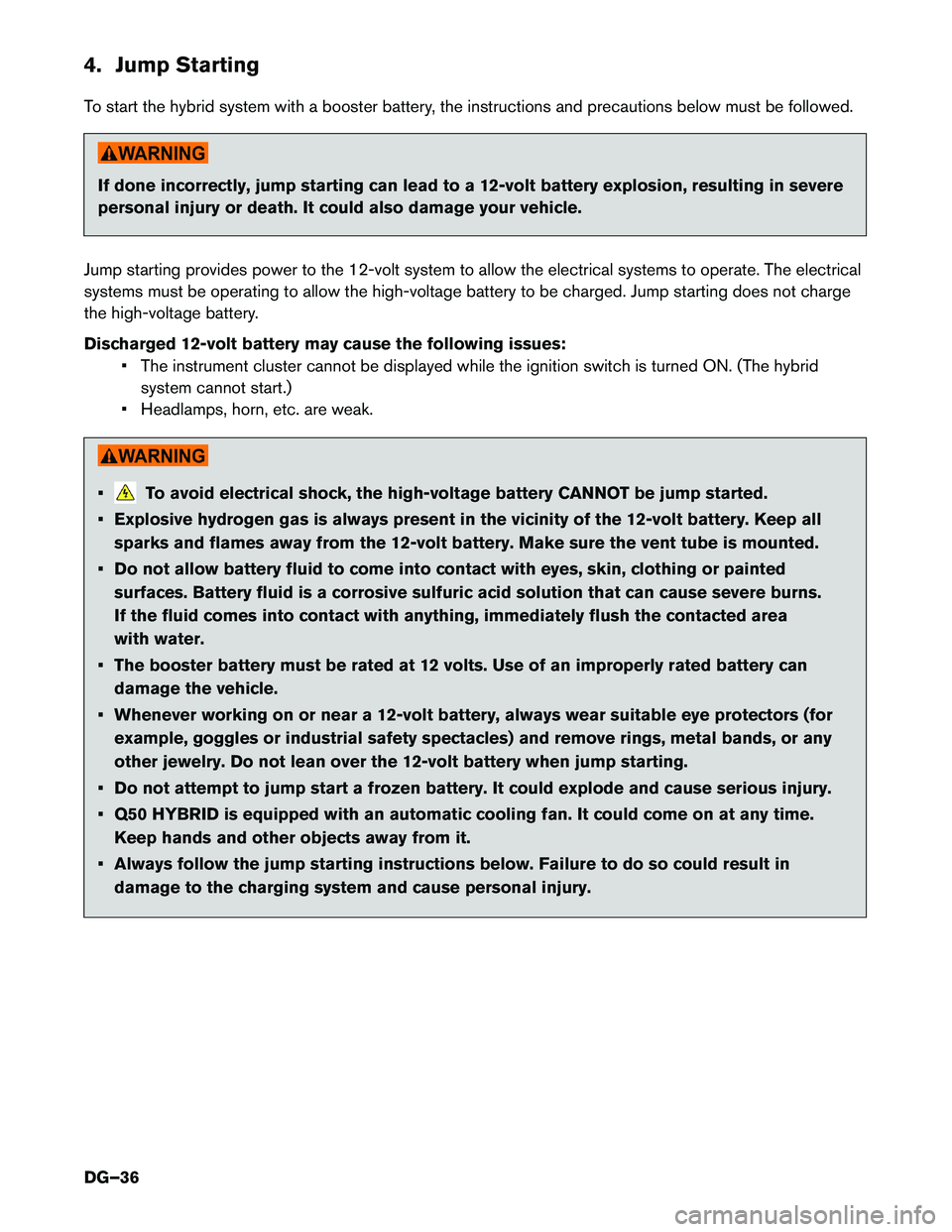charging INFINITI Q50 HYBRID 2017 Dismantling Guide
[x] Cancel search | Manufacturer: INFINITI, Model Year: 2017, Model line: Q50 HYBRID, Model: INFINITI Q50 HYBRID 2017Pages: 55, PDF Size: 2.25 MB
Page 5 of 55

1. About the INFINITI Q50 HYBRID
This
hybrid electric vehicle (HEV) uses two types of batteries. One is a 12-volt battery that is the same as
the battery in vehicles powered by internal combustion engines. The 12-volt battery is located behind the
rear seat back with battery cable access through the trunk area. The other is the high-voltage battery for the
traction motor which propels the vehicle. The high-voltage battery is located behind the rear seat back with
service plug access through the trunk area.
When the high-voltage battery level is low, engine output is used to generate power from the traction motor
and charge the high-voltage battery. Additionally, the vehicle system can recharge the high-voltage battery
by converting driving force into electricity while the vehicle is decelerating or being driven downhill. This is
called regenerative charging.
DG–5
Page 18 of 55

3-2 Personal Protective Equipment (PPE) and Insulated Tools
3-2.1
Personal Protective Equipment (PPE) Protective Wear Control
Perform an inspection of the Personal Protective Equipment (PPE) items before beginning work. Do not use
any damaged PPE items.
3-2.2 Daily Inspection
This inspection is performed before and after use. The worker who will be using the items should perform
the inspection and check for deterioration and damage. • Insulated rubber gloves should be inspected for scratches, holes and tears. (Visual check and airleakage test)
• Insulated safety boots should be inspected for holes, damage, nails, metal pieces, wear or other problems on the soles. (Visual check)
• Insulated rubber sheet should be inspected for tears. (Visual check)
3-2.3 Insulated Tools
When performing work at locations where high-voltage is applied (such as terminals) , use insulated tools
meeting 1,000V/300A specifications.
3-3 Discharge Procedures DANGER
Do not perform this procedure if the battery is damaged. If you are unsure of battery
damage,
use extreme caution and wear appropriate Personal Protective Equipment (PPE) .
High-voltage battery discharging must take place before dismantling. Sufficient discharging can be
achieved by following these steps. 1. Place the shift selector into the Park (P) position
2. Apply the parking brake.
3. Set wheel chocks to ensure the vehicle is completely immobilized.
4. Fasten the driver seat belt and close the driver door.
5. Apply foot brake and press the ignition switch to turn the system ON. Confirm READY indicator in instrument cluster turns ON.
a.
If the engine starts, leave the engine on until the idling stops.
b. If the engine does NOT start, move on to next step.
6. Remove the shift lock cover (A) using a suitable tool.
7. Push down the shift lock (B) using mechanical key as shown in the illustration.
8. Push the shift selector button (C) and move the shift selector to the Neutral (N) position (D) while holding
down the shift lock.
NOTE:
DO NOT press accelerator or foot brake after
moving the shift selector to the Neutral (N)
position. Otherwise high-voltage battery will start
to be charged. A
B C
D
DG–18
Page 20 of 55

3-4 How to Handle a Damaged Vehicle
3-4.1
High-voltage System Shut-Down Procedure
Any of the following procedures can shut down the high-voltage system. The dismantling operation canonly
begin after shutting down the high-voltage system. If the vehicle is heavily damaged, for example the high-
voltage battery is deformed, broken or cracked, appropriate PPE must always be used and the high-voltage
battery and high-voltage components must not be touched. DANGER
• Failure to properly shut down the high-voltage system before the dismantling
procedures
are performed will result in serious injury or death from electrical shock.
To prevent serious injury or death, NEVER touch high-voltage harnesses or components
without always wearing appropriate Personal Protective Equipment (PPE) . Appropriate
PPE must always be worn when touching or working on high-voltage components.
•When contact with high-voltage components or high-voltage harnesses is
unavoidable, or when there is risk of such contact, you must always wear appropriate
PPE. PPE must always be worn when touching or working on high-voltage components. • The vehicle contains parts that contain powerful magnets. If a person who is wearing
a
pacemaker or other medical device is close to these parts, the medical device may be
affected by the magnets. Such persons must not perform work on the vehicle.
• Be sure to verify that the READY indicator is off (if possible) , and the high-voltage
system
is stopped.
• After the high-voltage system is shut down, please wait approximately ten (10) minutes for complete discharge of the high-voltage capacitor. While waiting, do not operate any
vehicle functions.
• After shutting down the high-voltage system and removing the 12-volt battery negative (-) terminal, wait at least three (3) minutes to discharge the air bag capacitor. Even though
the 12-volt battery negative (-) is disconnected, the Supplemental Restraint System (SRS)
air bag maintains voltage at least three (3) minutes. During this time, there is a possibility
of sudden SRS air bag inflation due to harness short circuit or damage and it may cause
serious injuries.
• The 12V system will remain active even after the 12-volt battery negative (-) terminal is removed while the high-voltage system is active. This is because the charging system
will not shut down and power will be supplied to the 12V system and high-voltage system
continuously.
Before disconnecting the 12-volt battery terminal, if necessary, lower the windows, adjust the steering
column, adjust the seats, unlock the doors, open the trunk, etc. as required. Once the 12-volt battery is
disconnected, power controls will not operate.
DG–20
Page 36 of 55

4. Jump Starting
T
o start the hybrid system with a booster battery, the instructions and precautions below must be followed. If done incorrectly, jump starting can lead to a 12-volt battery explosion, resulting in severe
personal
injury or death. It could also damage your vehicle.
Jump starting provides power to the 12-volt system to allow the electrical systems to operate. The electrical
systems must be operating to allow the high-voltage battery to be charged. Jump starting does not charge
the high-voltage battery.
Discharged 12-volt battery may cause the following issues: • The instrument cluster cannot be displayed while the ignition switch is turned ON. (The hybridsystem cannot start.)
• Headlamps, horn, etc. are weak. • To avoid electrical shock, the high-voltage battery CANNOT be jump started.
•
Explosive hydrogen gas is always present in the vicinity of the 12-volt battery. Keep all
sparks and flames away from the 12-volt battery. Make sure the vent tube is mounted.
• Do not allow battery fluid to come into contact with eyes, skin, clothing or painted surfaces. Battery fluid is a corrosive sulfuric acid solution that can cause severe burns.
If the fluid comes into contact with anything, immediately flush the contacted area
with water.
• The booster battery must be rated at 12 volts. Use of an improperly rated battery can damage the vehicle.
• Whenever working on or near a 12-volt battery, always wear suitable eye protectors (for example, goggles or industrial safety spectacles) and remove rings, metal bands, or any
other jewelry. Do not lean over the 12-volt battery when jump starting.
• Do not attempt to jump start a frozen battery. It could explode and cause serious injury.
• Q50 HYBRID is equipped with an automatic cooling fan. It could come on at any time. Keep hands and other objects away from it.
• Always follow the jump starting instructions below. Failure to do so could result in damage to the charging system and cause personal injury.
DG–36